Jefferson Vineyards Wine Blog
The Incredible Guzman Family
For fourteen years, Hector Guzman and his family have cared for our vines. He, his wife, and his children have each participated in caring for our precious vineyards.
“I love to work in agriculture,” Hector told us, and it is his extensive agricultural experience that brought him to Jefferson Vineyards. “I like and appreciate this place,” he continues, “Working in the countryside is also something very beautiful and it relaxes me.” Every day, he looks after every vine – doing all work by hand to ensure the vines receive the utmost care. “Thinning the canopy and leaf pulling are my favorite part of taking care of the vines” he explains. These critical processes take place over the summer months – a careful hand-made adjustment of the vines’ canopy to offer the grapes just the right degree of air and light to thrive.
Emily, Hector’s daughter, joined her father in caring for our vines about three years ago. She takes after her father in his enthusiasm and skill: “I enjoy working with my family and at Jefferson Vineyards because it is a very calm and happy place where I can still enjoy time with my family and learn more about the care of the vines that my dad knows of. Like how to take care of the vines for them to grow healthy. This year has been a great grape picking season and it was great due to all the great work my dad and everyone who helped him out to take care of the vines throughout the whole year.”
You’ll find Hector and his family most happily caring for the Chardonnay vines in our spectacular Upper Vineyard with views stretching across our estate’s rolling hills. Each task is completed by hand, each vine receives the ultimate care. It is to Hector and his family that we owe the vigor of our vines and the quality of our fruit. We are deeply grateful to have them as part of our team.
A Wine Transformed - Petit Verdot
In 1984 our vineyard and its vines were just a few years old, and even Virginia as a growing region was itself budding and new. Yet, taken by the potential of our land, we were fast at work developing the wine region to come. Our winemaker in 1984, Gabriele Rausse, who joined us after playing a critical role establishing Barboursville Vineyards, busied himself grafting new vines - many of which were the same varietals Thomas Jefferson himself has grown centuries prior. Among these experimental grafts was Petit Verdot.
Petit Verdot, pronounced “peh-tee vur-doe”, is a bold red wine. Hailing from France’s renowned Bordeaux region, it is one of the five grapes that typically compose the equally legendary Bordeaux blend. A dark and velvety hue in the glass, Petit Verdot is bold and distinguished. Deep fruit aromas like plum, blueberry, and dark cherry on the nose, with herbal flavors on the palate and warm tannins on the finish define this elegant wine. Historically, however, Petit Verdot was rarely showcased on its own.
The name “Petit Verdot” translates loosely to ‘little green one’, due mostly to its late ripening cadence, meaning the grapes were frequently still somewhat green by harvest’s time [1]. Accordingly, it was used in small amounts in blends, added to give tannic structure to the wine, and lend interesting tasting notes like violet or sage [2]. But no longer is Petit Verdot confined to a supporting role.
In 2001, Jefferson Vineyards was among the first Virginian vineyards to bottle a single varietal Petit Verdot. Two decades later, single varietal Petit Verdot maintains a place amongst our portfolio’s darlings. We showcase Petit Verdot as a single varietal wine, celebrated its strengths as a blending grape, and have used it as the foundation for many of our beloved Meritage blends (a new world take on the old world Bordeaux blend). Each iteration highlights the strength of this special varietal and we are humbled by the accolades we have collected for our Petit Verdot over the years.
How apt a varietal for October, a transitional season between Fall and Winter, then a varietal which itself has been transformed. Deep, velvety, and warm, Petit Verdot no longer is found listed only in the blend’s composition. It, as a single varietal wine, has shaped our trajectory for decades and has come to be celebrated as defining Virginian wine.
This October, we celebrate a grape that, though it is one of the last we harvested, is well worth the wait. Enjoy our oldest Petit Verdot as a single varietal, Petit Verdot 2016, with a bouquet of vanilla and caramel on the nose, coffee and berry flavors on the palate, and a warm, lingering finish with hints of cherry. Our 2018 Petit Verdot vintage opens with dried red fruit and hints of tobacco on the nose, the palate is smooth and integrated with vibrant fruit and black tea flavors, before a bright acidic finish with raspberry and sandy tannins. Or, enjoy a newer vintage - our 2019 Petit Verdot has dried fruit and oak on the nose, with a vibrant palate of red berry flavors before a bright, lingering finish filled with raspberry notes and warm tannins Alternatively, our 2017 Petit Verdot Reserve is made from only the best fruit. This lovely wine opens with aromas of vanilla and cedar, the palate displays berry, plum, and raisin flavors before tart cherry notes in the finish. Experience each (and more) in our Featured Wines Shop.
[1] "Guide to Petit Verdot Red Wine". Wine Folly, Wine Folly, 10 Mar. 2016, winefolly.com/deep-dive/guide-to-petit-verdot-red-wine.
[2] Ibid.
Heather Lavelle, Our Retail Operations Manager
"Let’s talk about aging and fermenting. No, I’m not talking about myself. Well, maybe. But let’s start with one of my favorites, Chardonnay. No this isn’t what you think. Chardonnay is probably the most versatile grape out there. Chardonnay has a style for everyone.
2019 was a spectacular year in Virginia wine. Here at JV, we are so excited about all of our 2019 vintage. As for me, I’ve completely fallen head over heels in love with our 2019 Chard Reserve. I must say it’s my favorite wine Chris has ever made. Even better than the elusive 2016 Viognier. Why? It’s a perfectly balanced wine. The nose is light citrus, brioche, and vanilla. The palate is apple, pear, yellow peach, butterscotch, almond, brioche, and a touch of spice. The finish is long with butterscotch, brioche, apple, and pear. I would pair this with a heavily aged sharp cheese. Think cheddar, gouda, gruyere. As for our stainless-steel Chardonnay, the 2019 doesn’t disappoint. Need a little zip in your life? Our 2019 Chardonnay does the trick. Green apple, citrus, and licorice on the nose. On the palate, green apple, banana, and citrus. It finishes tropical, with bright acidity. It’s zippy. This is the perfect hot weather wine."
- Heather Lavelle, Our Retail Operations Manager
To celebrate our 40th Anniversary and enjoy our Featured Wines, click here.
Allison Scott, Office Manager
"Jefferson Vineyards' Vin Rouge is one of my favorite red wines, and July is my favorite month – surprisingly they pair really well together. The juicy red strawberry and rose-scented notes of this wine bring back memories of warm summer evenings. The fruity qualities are even more delightful when the wine is served slightly chilled. I love the surprising twist of slightly chilling a Boudreaux blend, and it’s a nice break when everyone is white wined out. Pop it in the fridge for about 60-90 minutes before you want to serve, and it will be perfect! The Beaujolais qualities bring out the Francophile in me so I make a big plate filled with creamy semi-ripe cheese, chunky country pate, grilled bread – and call that dinner. Every July I look forward to my annual family reunion, and this year I plan to pour my friends and family chilled Vin Rouge!"
- Allison Scott, Our Office Manager
To celebrate our 40th Anniversary and enjoy our Limited Releases, click here.
Saving the Best for Last

As cooler temperatures settle in and begin warming up indoors, we’ve saved the best for last.
We at Jefferson Vineyards are celebrating our 40th Anniversary and looked back upon the last 4 decades. A viticultural vision conceived by a founding father and his Italian merchant friend; our land first grew grapes centuries ago. In these rolling hills nestled besides Virginia’s mountains Jefferson and Italian Viticulturalist, Phillip Mazzei, recognized terrain and climates capable of growing fine wines. Centuries later, an American diplomat enchanted by European wines had a similar vision. Founded first to bring friends, family, and guests from around the globe together around a bottle of wine. Shirley and Stanley Woodward established our vineyard in 1981. With the help of Gabriele Rausse, who had come to Virginia from Italy to help institute Barboursville Vineyards, we planted our first vines. Few other Virginian wineries existed at the time and our success followed ceaseless cycles of trial and error, resilience, and impassioned persistence.
In looking back, we found stories of resilience, of evolution, and of steadfast commitment to our core. Passed from generation to generation, Jefferson Vineyard’s story unfolded in the hands of family and friends. With it, our wine and wine programs too have evolved. The best of which are our Estate Reserve Wines into whose creation and production we have infused more thought, more consideration with each year, especially over the last four years.
Our winemaking team dedicates themselves fully to each wine. They could tell you everything about each barrel in our winery and every wine inside. Our Estate Reserve wines are the best of our already best efforts. Made from our vineyard’s best top fruit, Estate Reserve wines are given extra care from the vines to the bottle.
Estate Reserve wines come from our vineyards’ best finest blocks. Though we can’t control the weather or what pests choose to visit the vines, we take every precaution to protect our fruit and push it to optimal ripeness before harvesting. We added fencing and net nearly all of our vines to protect them from the elements and fauna. For the blocs we predict our Estate Reserve will come from, we drop fruit. When we drop fruit, we take, a quality over quantity approach that encourages the vines to pool their energy to what fruit remains hanging, while the dropped fruit is used elsewhere. As early as 2017, we began dedicating certain two-acre blocks to push the fruit to optimal ripeness, waiting as long as possible before harvesting to bring about higher sugar levels, higher tannin levels, deeper color, and more - the best fruit.

When our greatest fruit reaches optimal sugar levels, we bring it to the winery and here we start the process of crafting it into our to become an Estate Reserve wines. Purposeful consideration continues. For Estate Reserve wines, our winemaking team prefers new, French oak barrels. Estate Reserve wines will age for far longer than our other wines. Where approximately eight months will do for our other wines, Estate Reserve wines age for sixteen to twenty-four months. The tighter grain of young French oak barrels better manages this aging process and lends a more elegant finish to the Petit Verdot, Merlot, Cabernet Franc, or Viognier of which our Estate Reserves are so frequently comprised.
The varietals from which our Estate Reserve wines are usually created – Petit Verdot, Merlot, Cabernet Franc and Viognier - are the varietals that grow best on our land. They capture the best expressions of this place, the potential of which engendered our story. The 2014 Estate Reserve, for instance, is a fine wine made entirely of Petit Verdot. Aromas of cherry layered with vanilla open before luxurious blackberry and raspberry flavors on the palate, followed by a velvety finish with ripe blueberry notes. Our 2016 Estate Reserve is also composed of Petit Verdot but a different vintage offers a different experience. Notes of vanilla, spice and fig on the nose, preface a balanced palate of plum and wet stone and a lengthy finish with spice, heavy tannins, and hints of cedar. The following year’s Estate Reserve, 2017 Estate Reserve, is based instead in Cabernet Franc, with notes of oak, herbs, and tobacco before a balanced palate and lengthy, refined finish. Our 2019 Estate Reserve White, on the other hand, opens with floral and ripe peach aromas. Soft layers of peach, lychee, and honeysuckle define the palate before a smooth, round finish with flavors of brown sugar and refreshing acidity. This elegant, refined Viognier wine just won a Double Gold medal at the prestigious 2021 San Francisco International Wine Competition, making it one of America’s finest wines.

Find these and more in our curated selection of Estate Reserve wines. So as we close a year of celebrating these past 40 years, we offer you tastes of our story from along the way - stretching as far back as 2012.
Allison Scott, Our Office Manager
Jefferson Vineyards isn’t the only one turning 40 this year. November marks a big birthday for me also, and I intend to celebrate with one of my favorite bottles of Jefferson Vineyards wine, our beloved Meritage 2014. The jammy nose and long herbaceous finish bring back memories of chilly fall evenings. And is delightful when served alongside a Thanksgiving meal; I prefer it towards the end of the meal, post-turkey! Whether you are going for an all-out traditional feast or a vegan version for two this wine will elevate any celebratory meal. This November in particular, I look forward to seeing my friends and family on Thanksgiving, and marking significant milestones together!
A Meritage Tradition
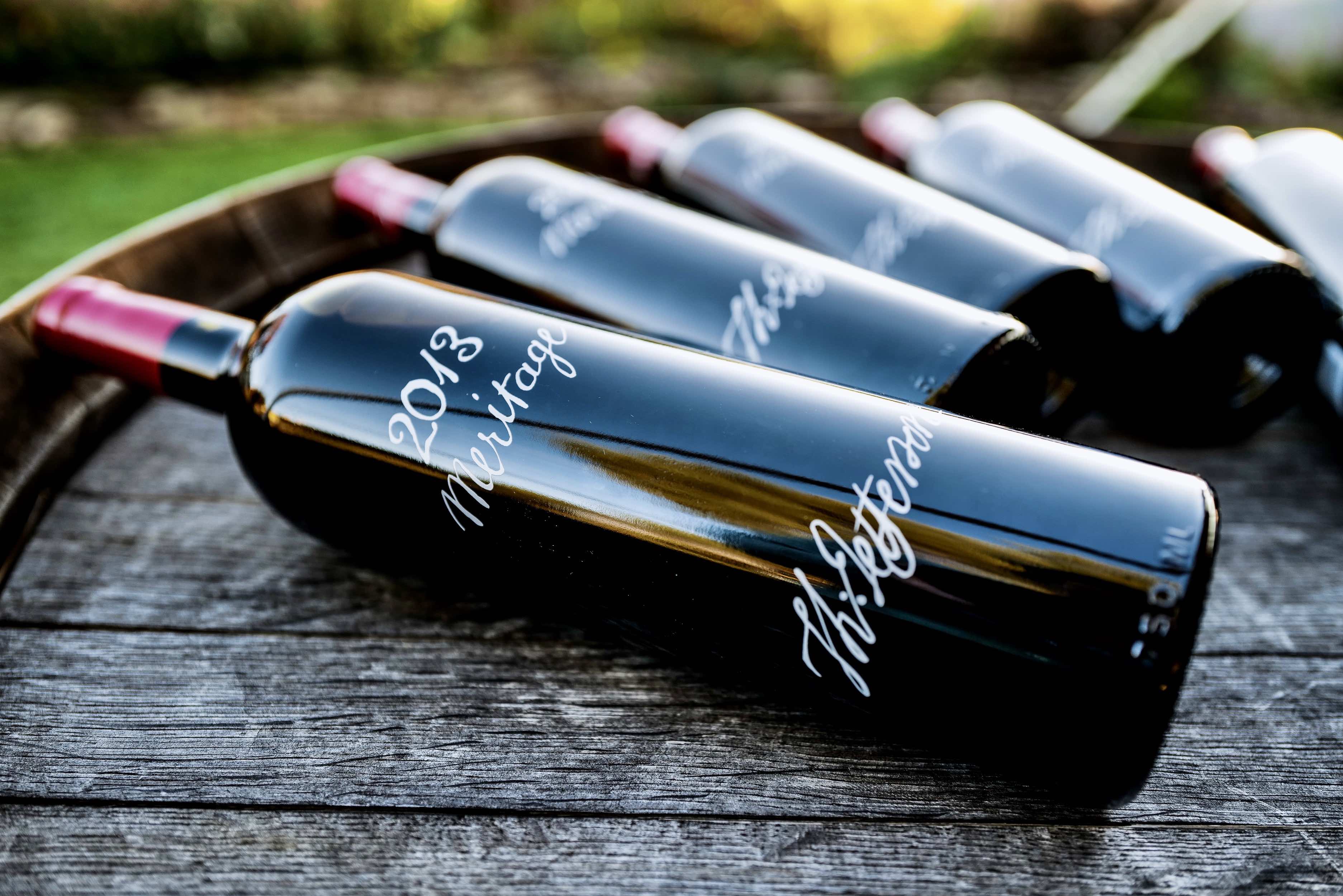
Not too long ago we collected the last of our grapes from their vines. Now, they’re fermenting in the winery, tucked away becoming something new, something unique. Meanwhile, our holiday plans take shape. Once again, we’re only a few weeks away from the holiday season. Traditions continue and evolve. Though this year may not be the same as last year or the year to come, the sentiment remains - time reserved for one another, time dedicated simply to be together, sharing a meal. Whatever this holiday season may bring, we look to our Meritage wines to exemplify tradition re-invented.
Meritage: A History
To be called a ‘Meritage’, the producing winery must be a member of the Meritage Association and be blended solely from Bordeaux grape varietals. The term ‘Meritage’, and the associated alliance, was founded in the late 1980’s to create a New World term for wines blended in the tradition of Bordeaux [1]. Combining “merit” and “heritage”, “Meritage” is a nod to centuries of viticultural tradition preceding.
A Meritage wine must contain two or more of the Bordeaux varietals, none of which can comprise more than 90% of the total blend [2]. Cabernet Sauvignon, Cabernet Franc, Malbec, Merlot, Petit Verdot, St. Macaire, Gros Verdot, or Carmenère are among the Bordeaux varietals. At Jefferson Vineyards, our Meritage blends are typically comprised of Petit Verdot, Merlot, Malbec, Cabernet Sauvignon, and Cabernet Franc. With every year, the included varietals, and their composition change. Each vintage continues in the style and tradition of Meritage and the centuries of Bordeaux blends before it - silky texture and robust structure. But each vintage, unique in composition, each varietal influenced by that year’s terroir creates a distinct new Meritage.

An Evolving Legacy
Our 2013 Meritage, our oldest vintage, composed predominantly of Petit Verdot, opens with robust coffee aromas on the nose, the palate is bright and filled with flavors of blackberry and spice, before a long and lingering finish. Yet, 2014 Meritage, still comprised mostly of Petit Verdot, is strikingly different though produced just one year later. Where coffee aromas previously set the tone, notes of spice, cedar fennel, almond and berry open the 2014 vintage. On the palate, berry flavors again dominate but blueberry and raspberry flavors are especially pronounced before a vibrant berry finish that lingers as its antecedent did but is instead, infused with notes of vanilla and more spice. The next iteration, 2015 Meritage, again maintains the Meritage family’s smooth and structured distinguishing characteristics but again, like each year’s iterations, differentiates itself. On the nose cedar, oak, and blackberry notes intertwine, the black cherry flavors preside over the palate with a bright acidity before more cherry and berry flavors mingle in the tannic finish with lingers spice notes. The pattern continues.
A Symbol of Tradition
The nuance of each Meritage expands the range of complementary food pairings, but certain combinations will never disappoint. For darker meats, fattier meats, nearly any Meritage will do. Chilled Meritage of any vintage balances the charcoal seasoning given to food by the grill. Enjoy your 2017 Meritage with roast pork, or our 2018 vintage with lamb. Explore Meritage from year to year, finding in each vintage a new food pairing, a new experience. Find the above-mentioned vintages and more in this month’s featured wines.
Meritage wines transform with every passing vintage while holding steadfast to wine’s core characteristics. It is a new experience with each year not dissimilar to the holiday traditions around the corner. Whatever traditions have or have not changed for you and your loved ones this holiday season, we hope you stay true to the core of your celebrations, stepping aside to cherish time together.

[1] What Is Meritage? - Meritage Alliance. http://www.meritagealliance.com/what-is-meritage/. Accessed 3 Aug. 2021.
[2] Red Meritage - What Is Meritage? - Meritage Alliance. http://www.meritagealliance.com/what-is-meritage/red-meritage/. Accessed 3 Aug. 2021.
The Wonderful World of Cabernet Franc
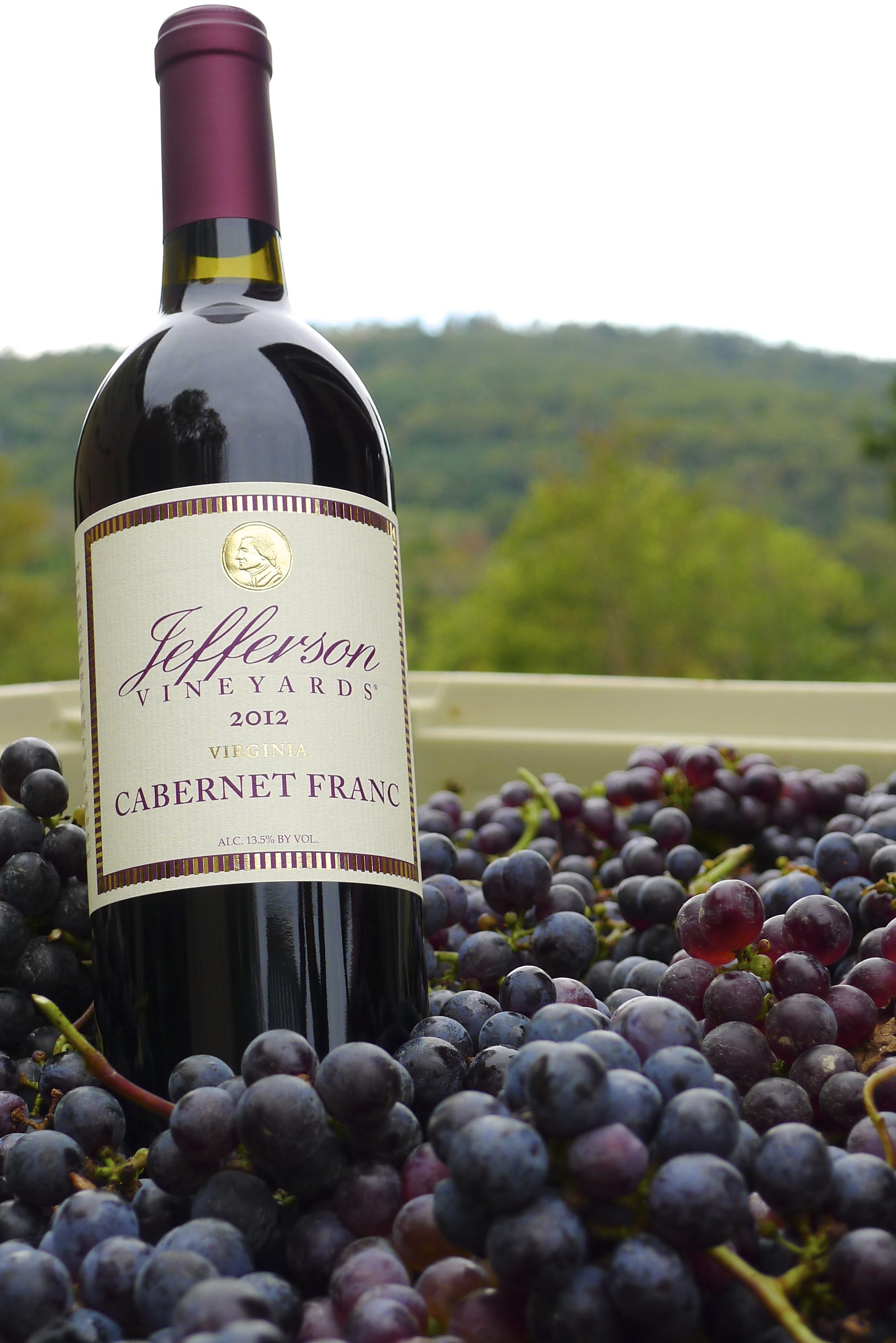
Finally, it begins. After a year of patience, a year of care, monitoring every vine, every cluster of new fruit, a year spent optimistically, expectantly - it begins again. Harvest, and with it, the start of a new vintage.
For the entirety of each year, we turned our attention to our vines. We hold our breath with every drastic turn of the weather – from Winter’s coldest nights to Spring’s heaviest rainfalls, and Summer’s blistering heat. For months, our team busied themselves cutting away rogue shoots and training the remainder to grow up towards the sky. We manually pulled leaf by leaf from the vines, regulating how much light reaches the growing fruit and ensuring air will flow freely through the trellised vines. Hundreds of hours spent between the neat vineyard rows, spent in every season, taking notes on the vines’ response to the heat, humidity, and parched earth, waiting to arrive, finally in Fall.

We began by harvesting the white varietals, the earliest to break bud, and which, in late August are first ready to be harvested. Pinot Gris and Chardonnay, alongside the Riesling and Viognier, mature most quickly, reaching the optimal brix levels (a measure of the fruit’s sugar). Day by day our team tests and records the fruits’ progression until now, when all indicate the best time to begin collecting fruit. Then, in September’s shortened days, the first of our red wines reach optimal maturity. It is at that time when we begin harvesting Cabernet Franc.

Cabernet Franc is an ancient varietal, the parent grape to the much-beloved Merlot and Cabernet Sauvignon varietals as well as the unique Carmenère grape. Hailing from France’s illustrious Bordeaux growing region, each of these grapes boasts bright red fruit flavors and supple tannins much like their Cabernet Franc parent. Merlot, Cabernet Sauvignon, and Cabernet Franc comprise what is known as the ‘Bordeaux Blend’. Borrowed from the same region in which these grapes originated, the Bordeaux Blend is primarily composed of Cabernet Sauvignon, Merlot, and Cabernet Franc, with smaller percentages of Petit Verdot, Carmenère, and Malbec. [1, 2] Though the percentages of each will vary from place to place and winemaker to winemaker, the blend itself is as renowned as its founding region.
Medium-bodied with strawberry, raspberry, and even bell pepper, the robust Cabernet Franc grape gowns amenably in a range of climates. In each, different flavors arise. In cold climates, the varietal’s sharp, tart flavors come forward and its acidity becomes more pronounced. In warmer climates the varietal’s sweeter side arises, sweet strawberry and dried fruit flavors become more pronounced. Cabernet Franc grows well in so many regions due, in part, to a group of compounds called methoxypyrazines. A naturally-occurring pest deterrent, methoxypyrazines create a pepper flavor in the wine. This flavor too will change with climate but is most frequently described as bell pepper. [3]

Cabernet Franc flourishes in our vineyards and across Virginia. We presently grow our Cabernet Franc in our Apple Vineyards where they are protected from the afternoon heat and their acidity is better preserved. We supplement our vineyard’s fruit with Cabernet Franc from Silver Creek vineyards located 40 miles down the road to protect against the unpreventable and offer diverse Cabernet Franc flavors. Yet, Jefferson Vineyard’s history with Cabernet Franc is nearly as old as we are. We first planted Cabernet Franc decades ago. Ever since, it has been a darling of our portfolio.
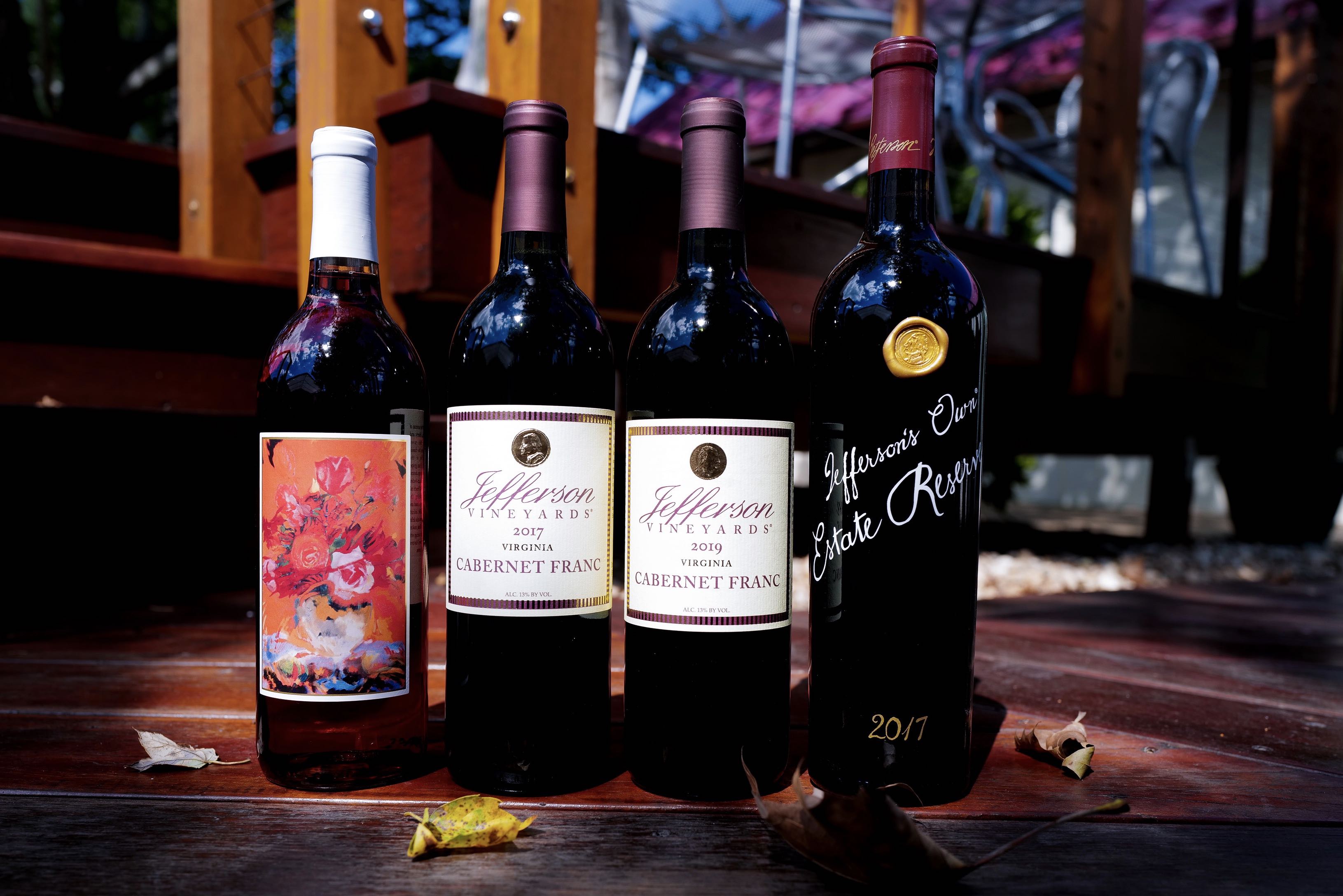
Our most recent 2019 vintage opens with aromas of dark cherry, vanilla, and floral components, before cherry and blackberry on the palate. With medium tannins and balanced acidity with a smooth finish, this wine was awarded Gold in the 2021 Virginia Governor’s Cup. But our Cabernet Franc offerings don’t stop there. To celebrate this robust, historic grape and its many flavors, we’ve collected our best Cabernet Francs in this month’s Featured Wines. There you’ll find our 2019 vintage as well as our highly awarded 2017 Cabernet Franc. In this vintage, aromas of dark cherry and cedar mingle with luscious dark fruits and balanced acidity on the palate before flavors of vanilla, and light pepper in the finish complements its soft palate. Should you prefer big, bold reds, you’ll also find our 2017 Estate Reserve. Comprised 52% of Petit Verdot and 48% of Cabernet Franc, this wine showcases Cabernet Franc’s strengths as a blending grape. With oak and spice on the nose, a strong acidity on the palate with black tea flavors before a fruit-forward finish, and balanced tannins, this bold wine is worth saving. To experience our Cabernet Franc in a totally new light, enjoy our Off Dry 2018 Rosé with pomegranate on the nose, ripe cherry, and juicy berry on the palate before a semi-sweet finish with a hint of tannin.
Our eager anticipation for Harvest, the beginning of a new vintage, calls into sharp contrast the legacy of this ancient grape. From its roots in Bordeaux, as the parent to many of the world’s favorite varietals, Cabernet Franc has found a happy home here, in Virginia’s Albemarle County. Find iterations of Cabernet Franc of harvests of past in our Featured Wines selection, and enjoy the range of flavors and wines crafted from Virginia’s own Cabernet Franc as we look ahead to a new vintage.
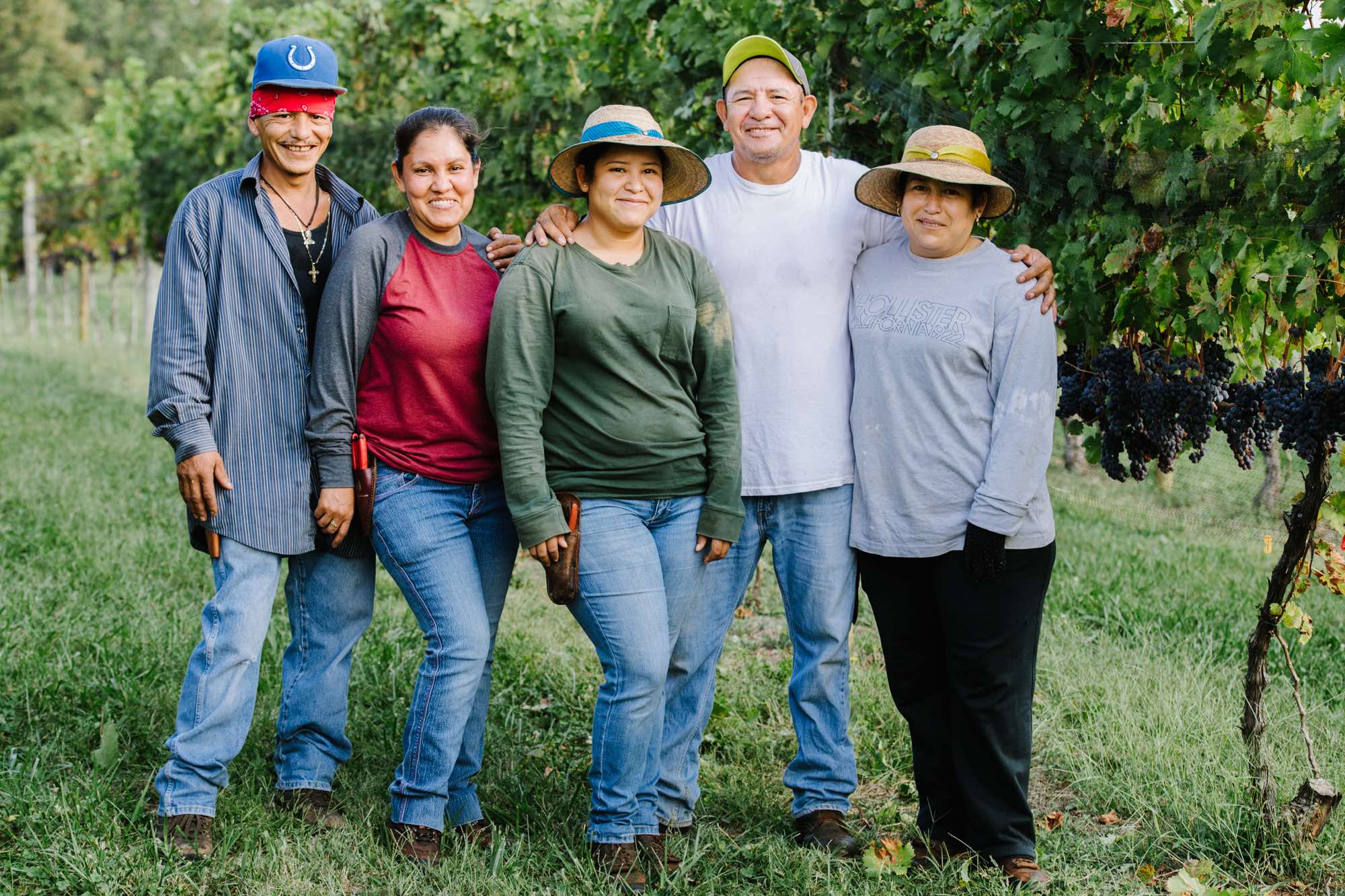
[1] Chris Mercer March 6, and Chris Mercer. “What Is a Bordeaux Blend? Ask Decanter.” Decanter, 9 Mar. 2020, www.decanter.com/learn/advice/what-is-in-a-bordeaux-blend 51789/#:~:text=A%20Bordeaux%20red%20blend%20usually,Blanc%2C%20Sauvignon%20Gris%20and%20Muscadelle.
[2] “What Grape Varieties Make up a Bordeaux Blend?” Wine Folly, 14 Apr. 2017, winefolly.com/deep-dive/what-grape-varieties-make-up-a-bordeaux-blend/.
[3] “Cabernet Franc.” Wine Folly, 12 Sept. 2018, https://winefolly.com/grapes/cabernet-franc/.
New Harvest & New Opportunities
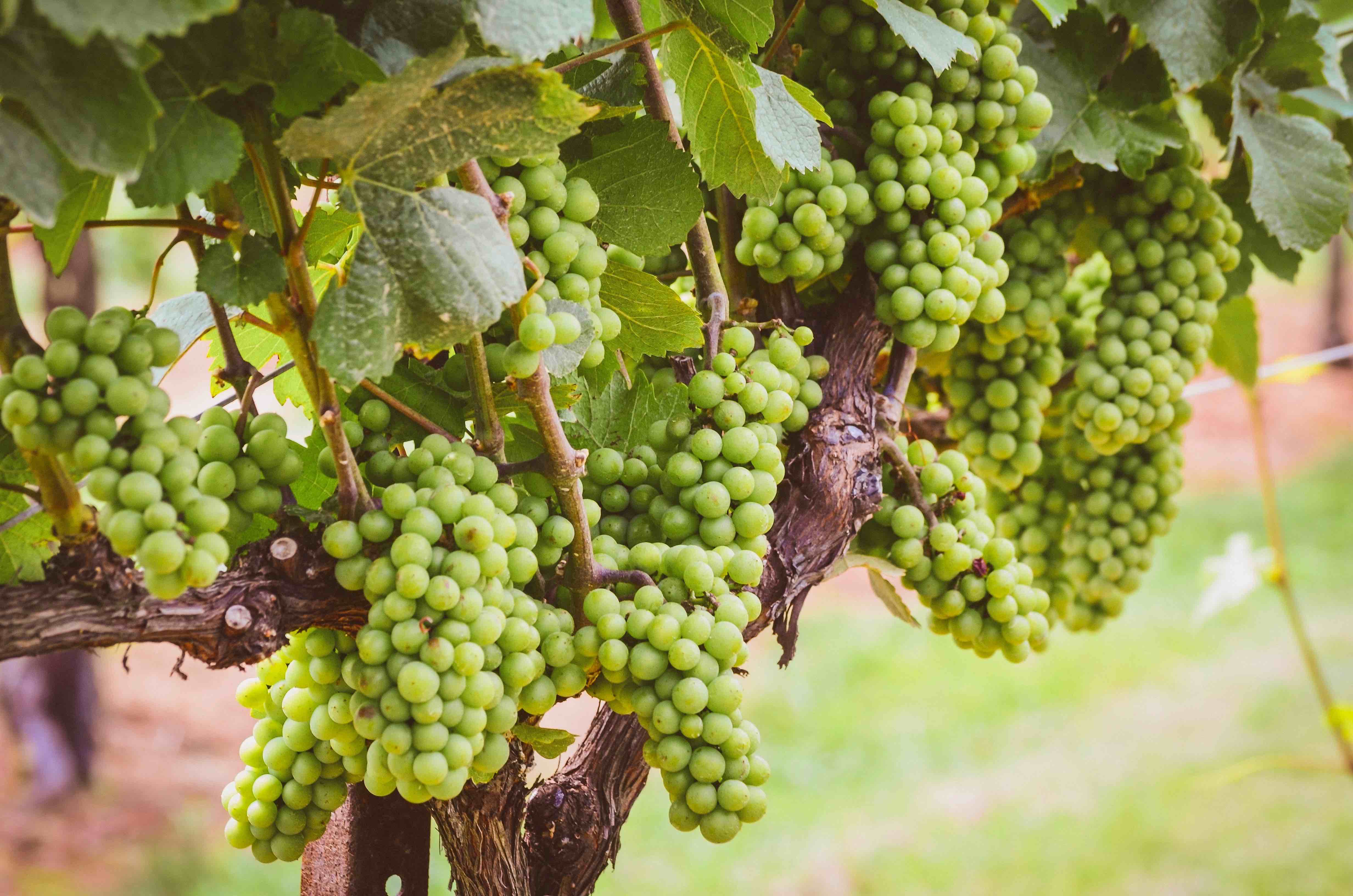
Harvest season is nearly upon us. With palpable excitement, our winery team is monitoring the grapes' evolution. Day by day, they collect samples from the grapes, eagerly anticipating the cue to begin harvest, the start of a new vintage. Each harvest renews a creative opportunity, a chance to enhance a harvest's particular essence in the winery, to highlight the best of every varietal in the wine you ultimately enjoy. Though there are standard procedures to which we adhere, the fermentation and aging processes give way to stylistic decision and the judgment of our wine-making team upon harvesting the fruit. With these decisions, fruit that may have come from the same part of the vineyard, perhaps even the same vine, become striking different wines, each worth enjoying.
Fermentation: A Tale of Two Choices

Once the grapes are harvested, processed, and sorted to remove any materials other than grapes (MOG), and they are taken into the winery. Here, they are pressed to break the fruits’ skins and release their juice before fermentation begins. Fermentation is the process by which the grapes and their juice become alcoholic. After a day or so, once the yeast is added to the grapes, the juice will begin to foam - an effect of the carbon dioxide released as the yeast consumes sugar from the grapes and produces ethanol in return.
White wines are quickly removed from the seeds and skins before fermentation while red wines sit with their skins, allowing the skins’ colors and tannins to impart on the wine. However, winemakers may choose to mimic this process with certain white wines, with optimal fruit quality and chemistry. By allowing these whites to sit with their skins and seeds longer, we make what are known as “skin contact” or “orange” wines. The additional time the white wine grapes spend with their skins alter the wine, adding a boldness and near tannic-life effect, and tinting the wine just slightly to become pink or orange in appearance. Take for instance the differences between our Pinot Gris and Skin Fermented Pinot Gris, or our Viognier and its skin-fermented counterpart.

Harvested from our Church Vineyard, our 2019 Pinot Gris has clean, floral, and citrus aromas, followed by pear and melon flavors before a crisp finish. From the same vines, but with additional skin contact, our 2019 Skin Fermented Pinot Gris wine is noticeably distinct. On the nose, would-be citrus aromas are instead mineral and floral. On the palate, the skin-fermented Pinot Gris is marked by delicate strawberry cranberry andvanilla flavors before a lingering, honeyed finish with mild tannins.
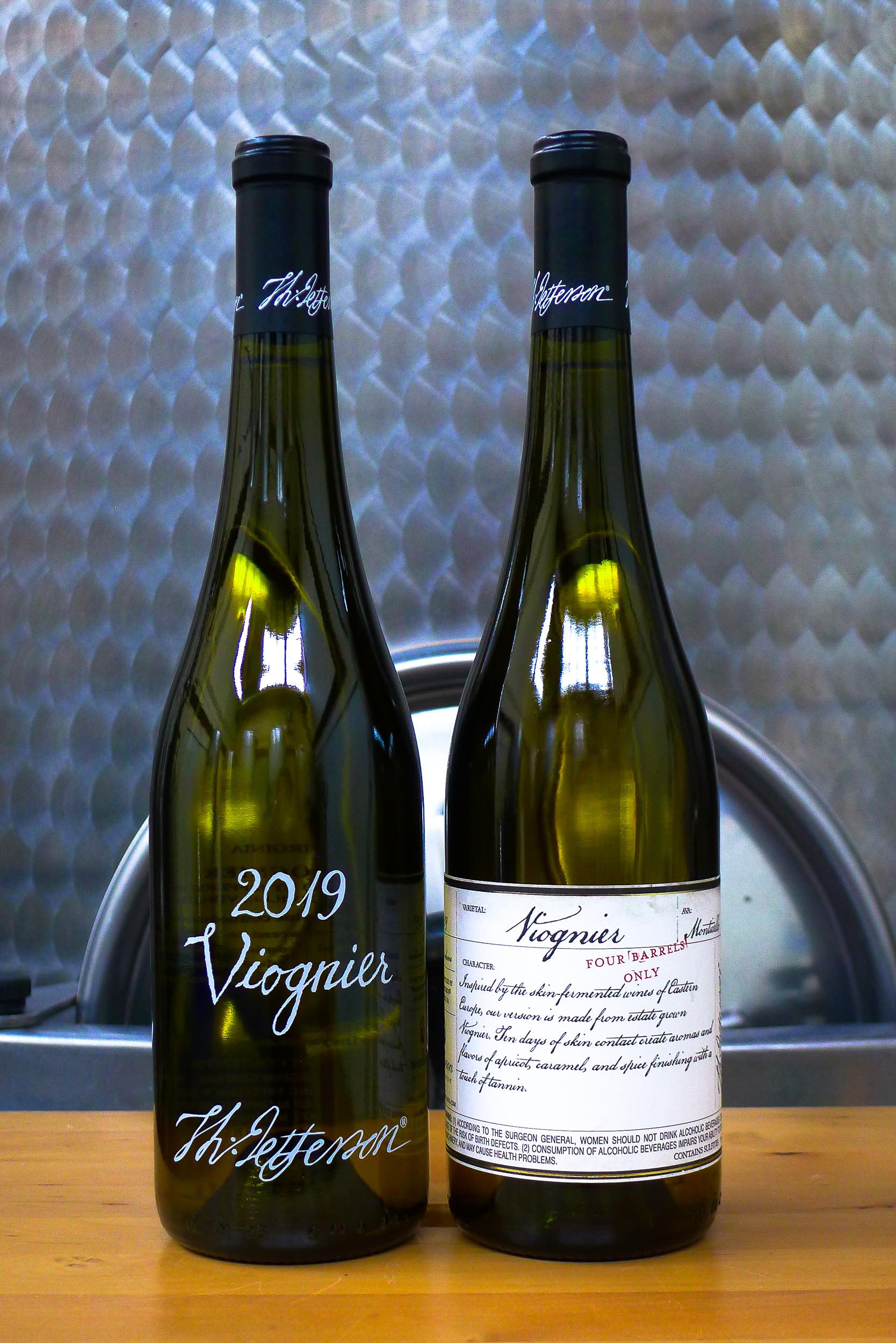
Our beloved Viognier is similarly transformed by skin fermentation. The 2019 Viognier claims intricate floral components, white peach, and nectarine; a delicate, balanced palate with additional peach flavors; and a lingering acidity in a predominantly floral finish. Alternatively, the 2019 Skin Fermented Viognier opens with prickly pear, citrus, and guava on the nose, a pleasant acidity on the palate is accented with tropical flavors of grilled pineapple and mango before a slightly tannic finish with notes of apricot.
Aging: Steel or Oak
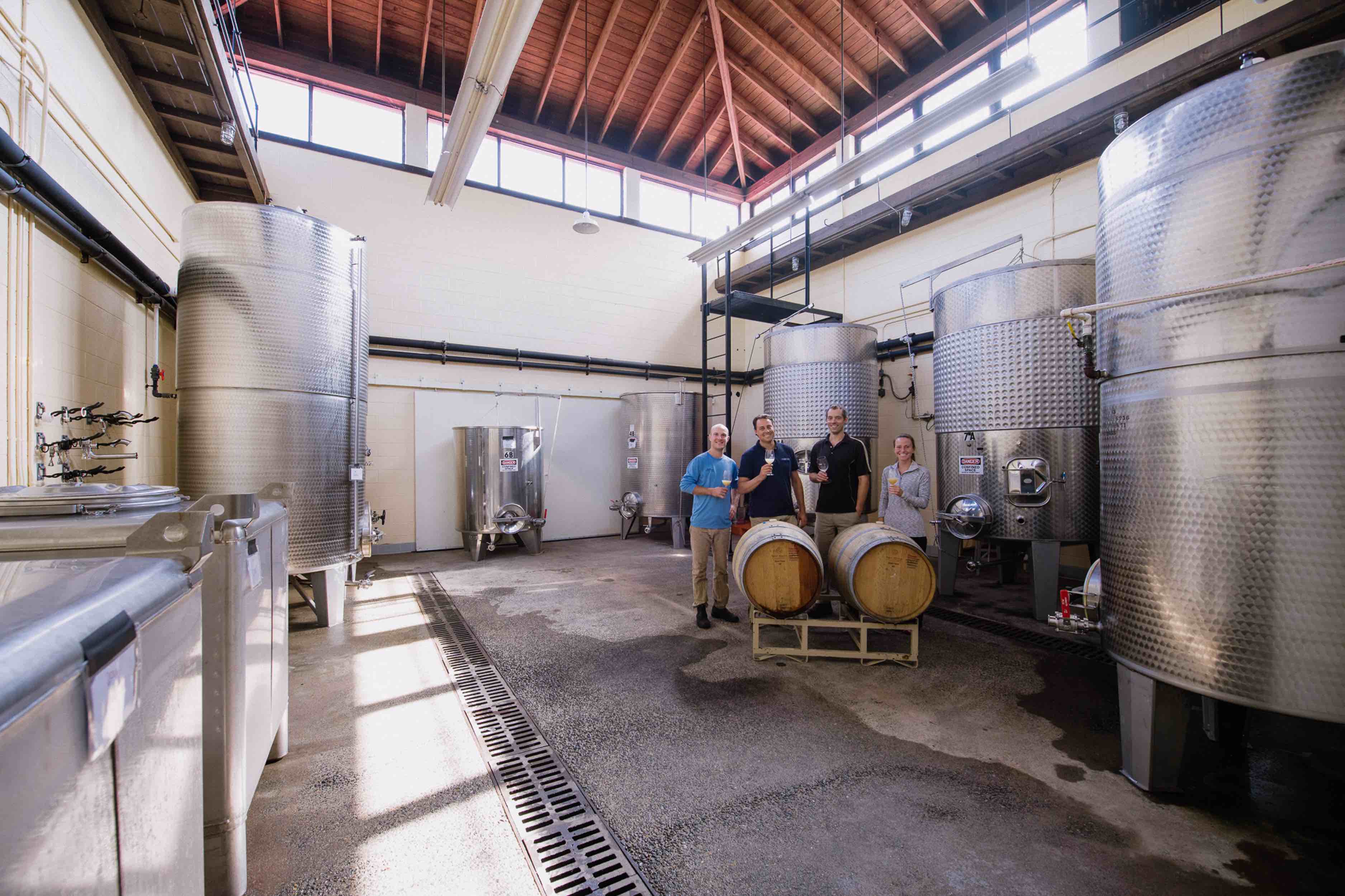
At the conclusion of fermentation, wine is ‘racked’ out of the fermentation tank and moved into a vessel to be aged. Again, our winemakers carefully consider how to age certain wines and different varietals. The age, treatment, and material of the vessels will impart unique characteristics on the wine and thus are considered as carefully as a chef would choose seasoning or a painter would mix a shade of color. Weighing the styles of wine for which we are known against the quality of a particular harvest and the magical chemistry that takes place inside the winery, our winemaking team prescribes a unique again process.

A barrel's oak type, age, grain, and treatment alter the wine. Wine aged in a young American oak barrel will be distinct from the same wine were it aged in old French barrels. As our winemaker, Chris Ritzcovan explains, “the addition of different barrels is akin to a spice rack in your kitchen. They are meant to enhance the wine, not overpower it”. We experiment with barrels of a range of oak species, from different regions, with differing treatments, and of varying ages to craft the best possible wine. As an organic material, oak barrels breathe, exposing a slow and steady supply of oxygen to the wine. The oxidation process diminishes the wine’s floral notes while allowing for richer flavors and greater smoothness to take hold. Alternatively, stainless steel tanks minimize oxygen exposure and thus the enclosed wine maintains bright floral and fruit flavors. Furthermore, if the influence oak barrel aging is akin to a spice rack, using a stainless-steel tank is to forego the spice rack entirely. A stainless-steel tank imparts no further flavor to the wine it holds, instead, the varietals’ flavors are untouched and maintained.

The difference between wines aged in steel versus oak vessels is best articulated by comparing our stainless steel 2019 Chardonnay and our 2019 Chardonnay Reserve. The stainless steel-aged 2019 Chardonnay opens with a bright bouquet of green apple and citrus. On the palate, the wine has tropical flavors with apple and pear before a crisp, acidic finish. Alternatively, the 2019 Chardonnay Reserve was aged for seven months in oak. This elegant wine opens with rich oak notes and vanilla on the nose, the palate is balanced with flavors of green apple and pear, before an elegant finish with notes of butter and toast.
A Call to Experiment
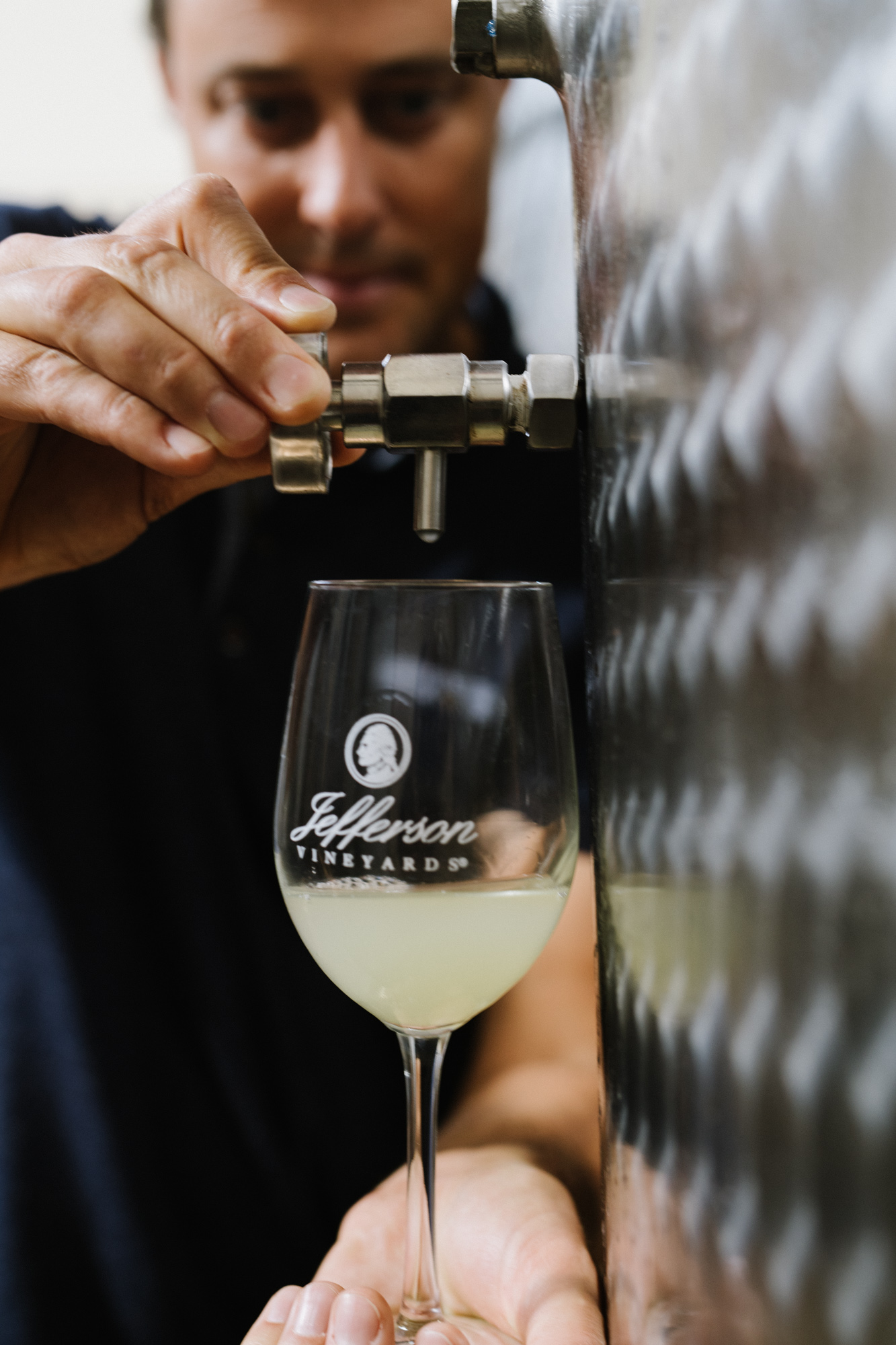
Throughout the winemaking process, we consider the nuances of each harvest and every varietal. Any decision made – be it fermentation technique or aging vessel – is made with consideration to the wine’s aromas, flavors, and notes. To taste wines made of the same varietal, grown on the same land, made unique by differing techniques is to directly taste the differences of a craft. This August, find every wine we mentioned above available for purchase in our Featured Wine Shop, paired with its fraternal twin. We encourage you to experiment, to try something novel to you – be it skin-fermented or stainless steel aged. Enjoy the transformed aromas, flavors, and finish between the two, and the varietal you thought you knew may transfigure into something new.
In the Winery: Bottling Whites and Preparing for Harvest
On July 28th, we continue with the exciting process of bottling wines. Not too long ago, we bottled red wines, soon we will bottle white wines. Of the white wines to be bottled is our 2020 Viognier, our flagship white, and two new 2019 white wines: Riesling Reserve and a dessert-style wine (more details coming soon). In bottling wine, we package a new vintage to be enjoyed. Around the same time, our team begins preparing for an entirely new harvest. All of our harvest equipment must be prepared for the harvest season ahead. Cleaned, sanitized, and checked to ensure all is in order. In a few short weeks, our team will begin testing the fruit and waiting for harvest to begin.

